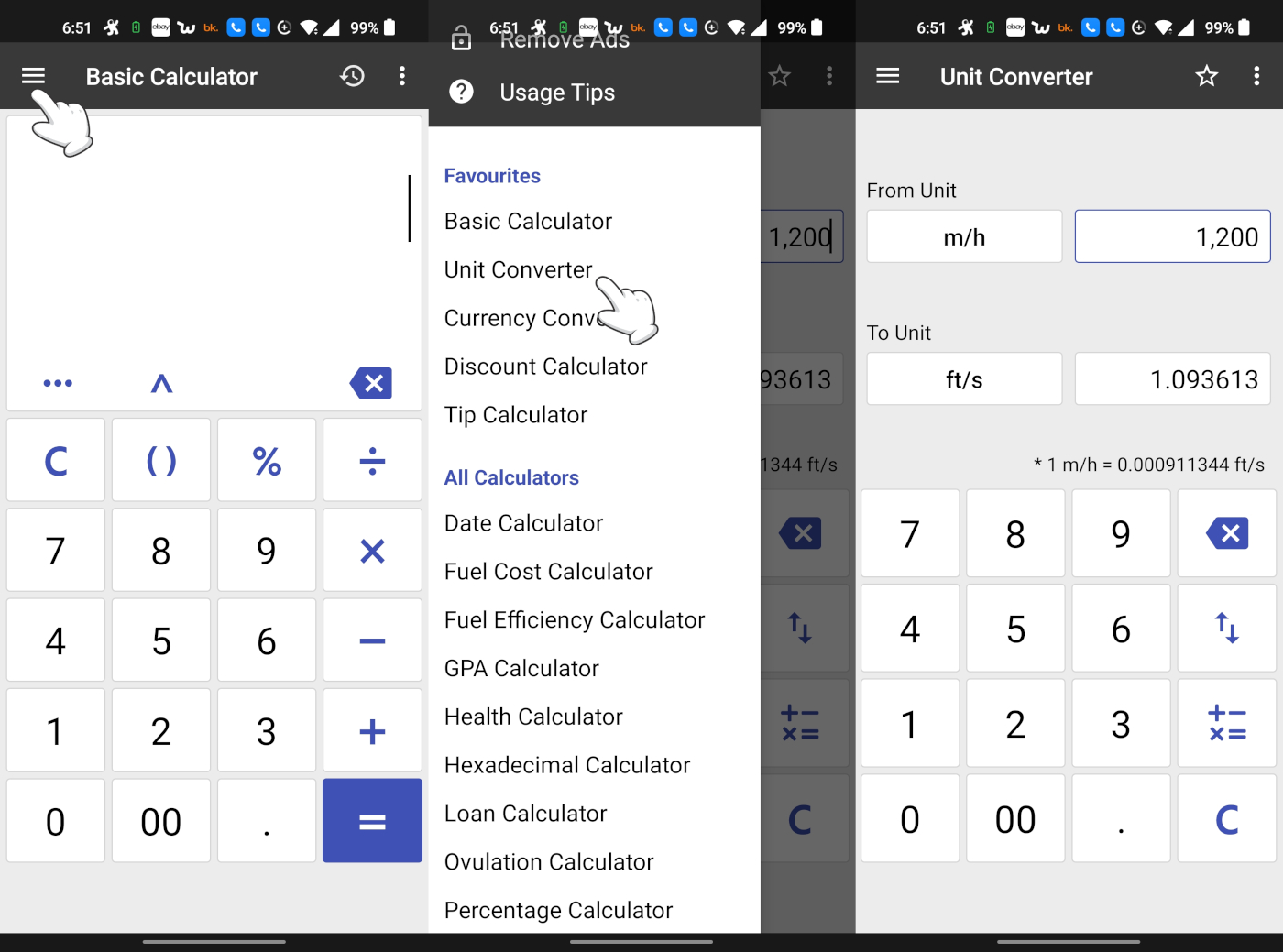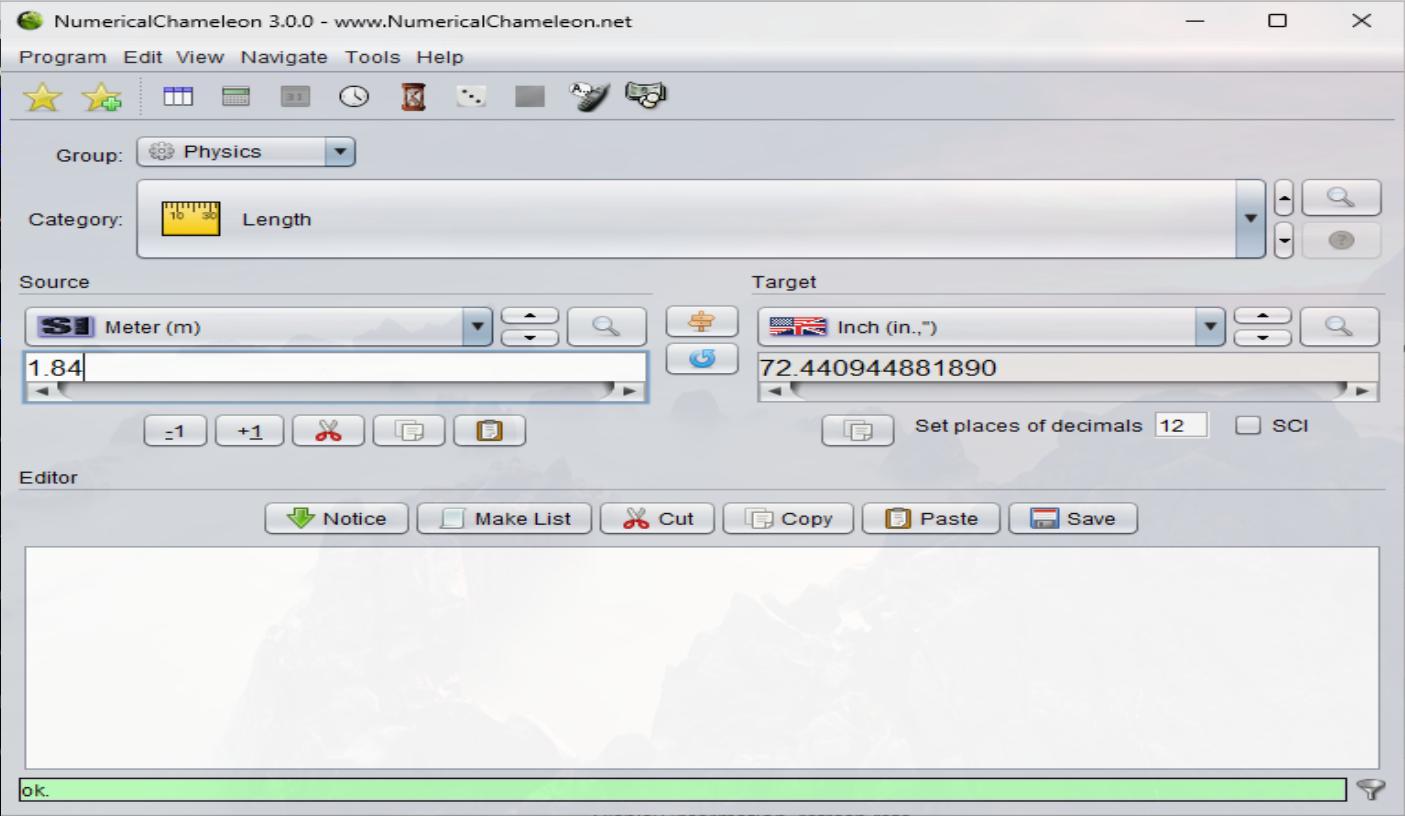
|
 |
 |
|
 |
One accurate measurement is worth a thousand expert opinions, Grace Hopper.
Unit conversion is the process of converting a quantity from one base or unit of measurement to another by multiplying or dividing it by a conversion factor. It expresses the quantity of a property as a different unit of measurement, e.g., time can be expressed in minutes or seconds instead of hours (2 hours = 2*60 minutes = 120 minutes = 120*60 seconds = 7200 seconds), distance or length can be converted from miles to feet (0.5 miles = 0.5 * 1609.34 meters = 804.672 meters), and volumen is usually measured in liters and gallons (5 liters = 5 * 0.264172 gallons = 1.32086 gallons).

To mentally calculate 497 + 598, adjust them to get round numbers (500 + 598 = 1098 or 500 + 600 = 1100), then correct after the sum is done (1098 - 3 = 1095, 1100 - 5 = 1095). 48 * 12 = 50 * 12 - (12 * 2) = 600 - 24 = 576. 15% de 36 = 10% of 36 + 5% of 36 = 3.6 + (10% of 36)/2 = 3.6 + 1.8 = 5.4.
It also supports all unit conversions commonly used in everyday life, such as length, mass, area, volume, time, temperature, force, energy, power, pressure, speed, fuel efficiency, and data size, e.g., 1200 m/h = (1200 * 3.28084)⁄(1 * 3600) ft/s (Remember: 1 m = 3.28084 ft, 1h = 3600 s) = 3937.008⁄3600 ft/s = 1.09361333333.
1 m = 39.3701 inches, and therefore, 1.84 m = 1.84 * 39.3701 inches = 72.440984 inches.

Qalculate! is a multi-purpose cross-platform desktop calculator. It is simple to use but provides the kind of power and versatility normally reserved for complicated math packages, as well as useful tools for everyday needs, such as currency conversion and percent calculation. The top buttons (from left to right) switches between the general and the programming keypad, switches between exact and approximate calculation, changes rational number form (Mixed fractions is selected by default), display mode (normal, scientific mode) and number base in result (binary, octal, decimal, etc.)
If you want to convert an improper fraction 7⁄3 to a mixed number, divide the numerator by the denominator (7 : 3 = 2 with a reminder of 1). Write down the quotient 2. Next, write down a fraction with the remainder (1) as the numerator and the same denominator of the improper fraction (3), 7⁄3 = 21⁄3. To calculate a conversion, open the unit conversion view (the ruler icon or Ctrl + U), select a Unit conversion from the list (e.g., Degree Fahrenheit, Degree Celsius), and type a quantity.

ConvertAll is another unit converter, but it can combine the units any way you want, e.g., 1/8 liter = 1000/8 mL = 125 mL. Other alternatives are Calculatormatic and WiseCalc.

There are people who think that Internet is Google. This is not true, but Google has become synonymous with easy searching and fast results. Google offers a built-in calculator among its many services.
It allows you to do: basic mathematical operations (2.5*3.5); percentages (50% of 220); units (45 cm to inches, 38 Celsius to Fahrenheit), and currency conversions (21 dollars into Euros); conversions between different numerical systems (12 in binary, 12 in octal, 12 in roman), quick plotting of a function, etc.

Pint is a Python package to define, operate, and manipulate physical quantities. It allows arithmetic operations between them and conversions from and to different units.
To install Pint, simply: python3 -m pip install pint.
user@pc:~$ python
Python 3.9.5 (default, May 11 2021, 08:20:37)
[GCC 10.3.0] on linux
Type "help", "copyright", "credits" or "license" for more information.
>>> from pint import UnitRegistry
>>> ureg = UnitRegistry() # It initializes a UnitRegistry() object. It stores the unit definitions, their relationships, and handles conversions between units.
>>> ureg.default_format = '.2f' # It defines the default formatting string, it rounds the result to two decimal places.
>>> temperature = ureg.Quantity(29, ureg.degC) # It defines a Quantity object (it describes a physical quantity) with a value (29) and the units of the physical quantity (Celsius).
>>> print(temperature.to('degF')) # It convert from Celsius to Fahrenheit.
84.20 degree_Fahrenheit
>>> distance = 10 * ureg.kilometer # distance is a pint.util.Quantity(10, 'kilometer') object
>>> print(distance.to(ureg.miles)) # It converts from kilometers to miles.
6.21 mile
>>> time = 7.0 * ureg.minutes # time is a pint.util.Quantity(7.0, 'minute') object
>>> print(time.to(ureg.second)) # It converts from minutes to seconds.
420.00 second
>>> speed = ureg.Quantity(45, 'm/seconds')
>>> print(speed.to('in/hour'))
6377952.76 inch / hour